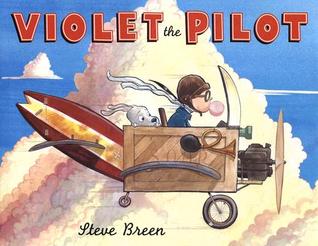 Why I Picked It Up: This was a recommendation from a librarian in one of our sessions last summer, and it took me entirely too long to actually pick it up! With a two-year-old that loves everything airplanes, we rediscovered it at the public library as we were browsing one day a few weeks ago. We’ve read it so many times that he can now quote many of the pages along with me as we read.
Why I Picked It Up: This was a recommendation from a librarian in one of our sessions last summer, and it took me entirely too long to actually pick it up! With a two-year-old that loves everything airplanes, we rediscovered it at the public library as we were browsing one day a few weeks ago. We’ve read it so many times that he can now quote many of the pages along with me as we read.
Why I Finished It: Violet the Pilot has such a wonderful message! It’s a classic tale of a kid who has amazing skills or talents and doesn’t quite fit in with everyone else. But despite ridicule from peers, Violet continues to pursue her dream and ends up using her talent in a selfless way and is eventually recognized as a hero. *warm fuzzies*
It seems like a simple story, but there is so much going on here! Lots of nods to early pioneers of aviation, lots of creativity and inspiration for young tinkerers, and beautiful illustrations with great attention to detail. My toddler giggles with excitement when he sees this book, and I don’t even mind multiple (sometimes even back-to-back) readings!
Who I Would Give It To: This is definitely an “all ages” kind of book. In addition to the toddler and myself, my husband, the aviation enthusiast, enjoyed reading it, as did the fourth grade class I read it to.
Integration Ideas
Maker Spaces
Violet is a tinkerer, a queen of makerspaces – she lives next to a junkyard and has an unending supply of odds and ends to help her hone her mechanical genius. Four pages of the book are devoted to the bizarre and wonderful flying contraptions Violet constructs. After just a few reads, my son was fitting together chip clips and twist ties and proclaiming it to be a “Bubtubbler.” This book can inspire creativity in anyone, and would be a wonderful way to begin a makerspace in your classroom or library.
According to The Librarian’s Guide to Makerspaces, makerspaces are “DIY spaces where people can gather to create, invent, and learn.” This is very nicely in line with the latest educational trends that push for students to have freedom to think and create such as Hour of Code (students learn to program), The Cardboard Challenge (students use cardboard boxes to create), and Genius Hours (students are given time to develop expertise in an area of their personal interest).
The thing that I like the most about a makerspace is that it can be anything you want, or need, it to be as long as it promotes and facilitates kids being creative. High-tech makerspaces probably come to mind when you think about this concept, those spaces that have 3-D printers, robotics equipment, and fancy computers. While this is fun, it is also expensive and not feasible for every school. A makerspace can be as simple as a pile of cardboard boxes and duct tape, or even a stack of notebook paper and pencils. It can have a focus, for example providing task-specific supplies for creating origami art or flying machines, or it can be broadened by providing a variety of supplies allowing kids to create anything they can think of. If you don’t have room for a permanent space, create a makerspace box full of supplies that can be pulled out and opened as time allows. As far as I can tell, it’s just about having the raw materials available for kids to use their imaginations.
Other creative books:
- Meggie Moon, by Elizabeth Baguley
- Rosie Revere, Engineer, by Andrea Beaty
- The Most Magnificent Thing, by Ashley Spires (Reviewed by Lit Fuse!)
Theme and Character
This book, and many of the books listed above, have a common theme driven by a strong capable heroine who continues pursuing her dream despite criticism or obstacles. The theme of perseverance is quite prevalent in children’s literature and this could easily be the focus of your time with this book. When introducing a perseverance, explain the meaning in kid friendly terms. One possibility is: continuing to do something despite difficulty or delay in achieving success. Ask students to discuss times when they continued to do something despite difficulty or delay in achieving success. Be prepared to share a few examples from your own life, since this is complicated for young students. Once students have had time to discuss times they have persevered, ask one of the following open-ended questions:
- Why is perseverance important?
- How does perseverance help one achieve their goals?
- What makes someone go the distance?
- What does it take to be the best?
- How can perseverance help communities?
Now it’s time to read aloud the story to the students. Establish the purpose of reading, which will be using the question you chose above and answering through the lens of Violet in the story. For example, if you Why is perseverance important?, students will discuss why perseverance is important to Violet. Not only is this open-ended question helping to discuss theme, but also characterization. If you designate specific stopping points to discuss Violet, you can chart responses and discuss at the end how Violet changes throughout the book.
If you want more books where a character perseveres, check out this list!
Research
Another reason I really liked this story were the subtle references to the greats of aviation that were sprinkled throughout the book. The only reason I noticed them was probably because I’m married to an a man who is crazy about aviation and I went through a phase (while preparing for Historical Fusions, one of our best sessions!) where I was fascinated by Amelia Earhart.
 A few references I noticed:
A few references I noticed:
- Among other things, Violet has a poster that looks quite like Charles Lindbergh on the wall in her bedroom.
- Violet paints the aircraft she intends to enter in the air show bright yellow, the same color that Amelia Earhart used for her first plane.
- Violet’s dog is named Orville, after Orville Wright of Kittyhawk fame.
I’m sure there are many others hidden in these pages! Any of these people would make very interesting studies for research, and this book might be the catalyst that sparks the interest to actually do the research.
From there, a timeline or Google Map might be just the thing! Here are a few examples:
How have you used Violet the Pilot in your classroom?






I like that this book can be integrated into a character trait lesson and that it has potential as a great way to introduce the idea of Makerspaces. I could see a lot of problem solving and growth mindset practice happening after reading Violet the Pilot. Nice pick.
Thank you, Michelle. Hope you have a great year.